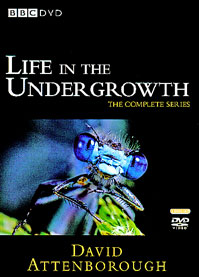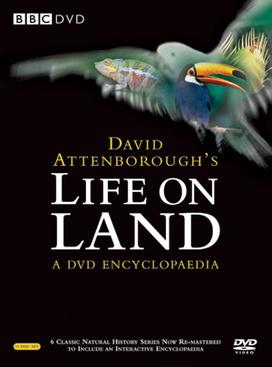
Sir David Frederick Attenborough is a British broadcaster, biologist, natural historian, and writer. He is best known for writing and presenting, in conjunction with the BBC Natural History Unit, the nine natural history documentary series forming the Life collection, a comprehensive survey of animal and plant life on Earth.

Life on Earth: A Natural History by David Attenborough is a British television natural history series made by the BBC in association with Warner Bros. Television and Reiner Moritz Productions. It was transmitted in the UK from 16 January 1979.

The Blue Planet is a British nature documentary series created and co-produced by the BBC and Discovery Channel. It premiered on 12 September 2001 in the United Kingdom. It is narrated by David Attenborough.

The Life of Mammals is a nature documentary series written and presented by David Attenborough, first transmitted in the United Kingdom from 20 November 2002.
The BBC Studios Natural History Unit (NHU) is a department of BBC Studios that produces television, radio and online content with a natural history or wildlife theme. It is best known for its highly regarded nature documentaries, including The Blue Planet and Planet Earth, and has a long association with David Attenborough's authored documentaries, starting with 1979's Life on Earth.

Life in the Undergrowth is a BBC nature documentary series written and presented by David Attenborough, first transmitted in the UK from 23 November 2005.

The Life Collection is a 26-disc DVD box set of nine titles from David Attenborough's Life series of programmes for the BBC Natural History Unit. It was originally released in the United Kingdom on 5 December 2005. The ninth title was added in a 2018 reissue. The collection has also been made available on Region 4 DVD in Australia and New Zealand, although it contains four fewer discs, as Life on Earth is not included.

Planet Earth is a 2006 British television series produced by the BBC Natural History Unit. Five years in the making, it was the most expensive nature documentary series ever commissioned by the BBC and also the first to be filmed in high definition. The series received multiple awards, including four Emmy Awards, a Peabody Award, and an award from the Royal Television Society.

Alastair David William Fothergill is a British producer of nature documentaries for television and cinema. He is the series producer of the series The Blue Planet (2001), Planet Earth (2006) and the co-director of the associated feature films Deep Blue and Earth.
John Michael Salisbury, is an English documentary filmmaker specialising in natural history programmes for television. In a career spanning four decades, he spent over 30 years working for the BBC Natural History Unit where he produced a string of award-winning series, many in collaboration with David Attenborough. He retired from the Unit in 2006 but continues to work as a freelance producer. In 2007, he was made an OBE in the New Year Honours List for his services to broadcasting.

The BBC Wildlife Specials are a series of nature documentary programmes commissioned by BBC Television. The series premiered in 1995, and 22 specials have been produced to date, with most of the more recent ones consisting of multiple episodes. The earlier programmes were produced in-house by the BBC's Natural History Unit, but the more recent Spy in the ... titles were made by the independent John Downer Productions. The first 18 specials, through 2008, were narrated by David Attenborough. Polar Bear: Spy on the Ice (2010), Penguins: Spy in the Huddle (2013) and Dolphins: Spy in the Pod (2014) were narrated by David Tennant.

Life is a British nature documentary series created and produced by the BBC in association with The Open University. It was first broadcast as part of the BBC's Darwin Season on BBC One and BBC HD from October to December 2009. The series takes a global view of the specialised strategies and extreme behaviour that living things have developed in order to survive; what Charles Darwin termed "the struggle for existence". Four years in the making, the series was shot entirely in high definition.

The Living Planet: A Portrait of the Earth is a BBC nature documentary series written and presented by David Attenborough, first transmitted in the UK from 19 January 1984.
The following is a chronological list of 148 television series and individual programmes in which Sir David Attenborough is credited as a writer, presenter, narrator, producer, or interviewee. In a career spanning eight decades, Attenborough's name has become synonymous with the natural history programmes produced by the BBC Natural History Unit.
Christopher Eugene Parsons OBE was an English wildlife film-maker and the executive producer of David Attenborough's Life on Earth nature documentary. As a founding member and a former Head of the BBC Natural History Unit, he worked on many of its early productions and published a history of its first 25 years in 1982. Besides television, he was also passionate about projects which helped to bring an understanding of the natural world to a wider audience, notably the Wildscreen Festival and ARKive.
First Life is a 2010 British nature documentary series written and presented by David Attenborough, also known by the expanded titles David Attenborough's First Life (UK) and First Life with David Attenborough (USA). It was first broadcast in the US as a two-hour special on the Discovery Channel on 24 October 2010. In the United Kingdom it was broadcast as a two-part series on BBC Two on 5 November 2010. First Life sees Attenborough tackle the subject of the origin of life on Earth. He investigates the evidence from the earliest fossils, which suggest that complex animals first appeared in the oceans around 540 million years ago, an event known as the Cambrian Explosion. Trace fossils of multicellular organisms from an even earlier period, the Ediacaran biota, are also examined. Attenborough travels to Canada, Morocco and Australia, using some of the latest fossil discoveries and their nearest equivalents amongst living species to reveal what life may have been like at that time. Visual effects and computer animation are used to reconstruct and animate the extinct life forms. Attenborough's Journey, a documentary film profiling the presenter as he journeyed around the globe filming First Life, was shown on BBC Two on 24 October 2010. A hardback book to accompany the series, authored by Matt Kaplan with a foreword by Attenborough, was published in September 2010.

David Attenborough's Life on Land: A DVD Encyclopaedia is a DVD box set of nature documentaries made by the BBC Natural History Unit. It comprises six series spread across 15 discs, all of them written and presented by David Attenborough, and together forming a comprehensive introduction to the major groups of terrestrial lifeforms. The series were filmed between 1987 and 2008, but are presented in the order in which the groups evolved, beginning with invertebrates and culminating with human beings, to tell the continuous story of the development of life on land. With a total running time exceeding 34 hours, it represents an in-depth visual survey of the living world as it exists today, at the beginning of the 21st century.
Keith Scholey is a British producer of nature documentaries for television and cinema, and a former television executive. He is currently a joint Director of Silverback Films Ltd and Studio Silverback Ltd.
Attenborough: 60 Years in the Wild is a three-part BBC documentary series chronicling the 60 years career making wildlife programmes of Sir David Attenborough. The first hour-long programme, titled "Life on Camera" was broadcast on Friday 16 November 2012 on BBC Two at 9pm. The second part, "Understanding the Natural World" and third and final part, "Our Fragile Planet" were broadcast on following Fridays, 23 and 30 November 2012.

Galapagos 3D is a British nature documentary series written and presented by David Attenborough, directed by Martin Williams and filmed in 3D. Attenborough returns to the Galápagos Islands for the fourth time in his career and travels throughout the archipelago to explain their origins and their unique fauna in evolutionary terms.













